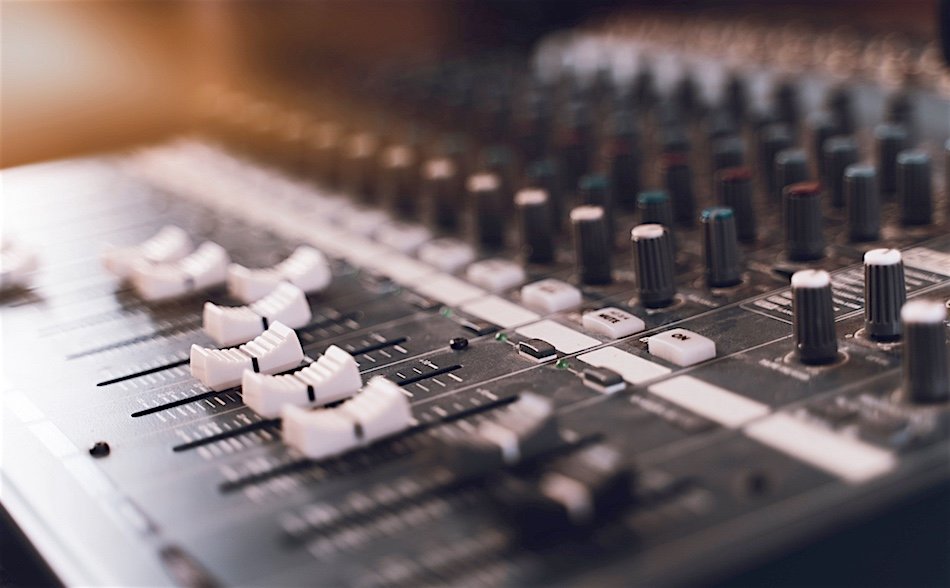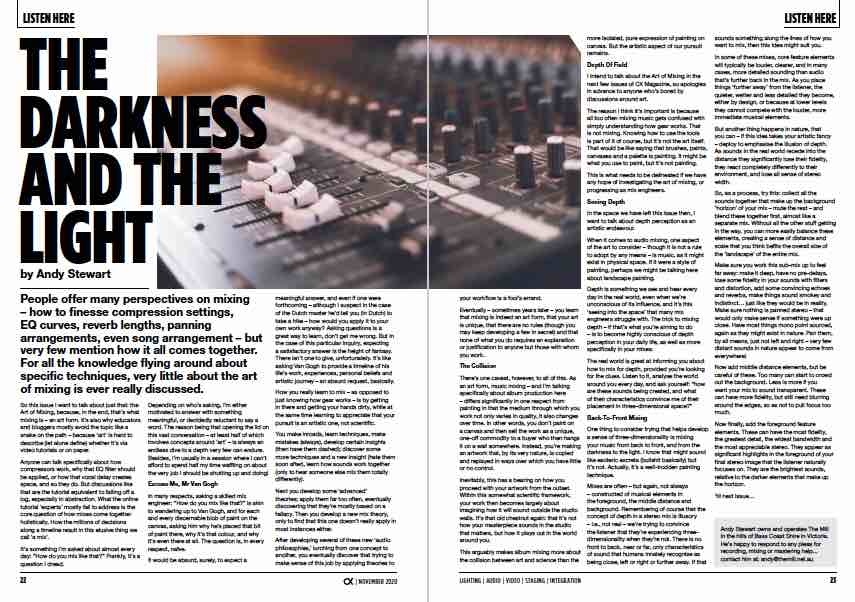Listen Here
13 Nov 2020
The Darkness and The Light

Subscribe to CX E-News
People offer many perspectives on mixing – how to finesse compression settings, EQ curves, reverb lengths, panning arrangements, even song arrangement – but very few mention how it all comes together. For all the knowledge flying around about specific techniques, very little about the art of mixing is ever really discussed.
So this issue I want to talk about just that: the Art of Mixing, because, in the end, that’s what mixing is – an art form. It’s also why educators and bloggers mostly avoid the topic like a snake on the path – because ‘art’ is hard to describe (let alone define) whether it’s via video tutorials or on paper.
Anyone can talk specifically about how compressors work, why that EQ filter should be applied, or how that vocal delay creates space, and so they do. But discussions like that are the tutorial equivalent to falling off a log, especially in abstraction.
What the online tutorial ‘experts’ mostly fail to address is the core question of how mixes come together holistically. How the millions of decisions along a timeline result in this elusive thing we call ‘a mix’.
It’s something I’m asked about almost every day: “How do you mix like that?” Frankly, it’s a question I dread. Depending on who’s asking, I’m either motivated to answer with something meaningful, or decidedly reluctant to say a word.
The reason being that opening the lid on this vast conversation – at least half of which involves concepts around ‘art’ – is always an endless dive to a depth very few can endure.
Besides, I’m usually in a session where I can’t afford to spend half my time waffling on about the very job I should be shutting up and doing!
Excuse Me, Mr Van Gogh
In many respects, asking a skilled mix engineer: “How do you mix like that?” is akin to wandering up to Van Gogh, and for each and every discernable blob of paint on the canvas, asking him why he’s placed that bit of paint there, why it’s that colour, and why it’s even there at all.
The question is, in every respect, naïve.
It would be absurd, surely, to expect a meaningful answer, and even if one were forthcoming – although I suspect in the case of the Dutch master he’d tell you (in Dutch) to take a hike – how would you apply it to your own work anyway?
Asking questions is a great way to learn, don’t get me wrong. But in the case of this particular inquiry, expecting a satisfactory answer is the height of fantasy.
There isn’t one to give, unfortunately. It’s like asking Van Gogh to provide a timeline of his life’s work, experiences, personal beliefs and artistic journey – an absurd request, basically.
How you really learn to mix – as opposed to just knowing how gear works – is by getting in there and getting your hands dirty, while at the same time learning to appreciate that your pursuit is an artistic one, not scientific.
You make inroads, learn techniques, make mistakes (always), develop certain insights (then have them dashed); discover some more techniques and a new insight (hate them soon after), learn how sounds work together (only to hear someone else mix them totally differently).
Next you develop some ‘advanced’ theories; apply them far too often, eventually discovering that they’re mostly based on a fallacy. Then you develop a new mix theory, only to find that this one doesn’t really apply in most instances either.
After developing several of these new ‘audio philosophies,’ lurching from one concept to another, you eventually discover that trying to make sense of this job by applying theories to your workflow is a fool’s errand.
Eventually – sometimes years later – you learn that mixing is indeed an art form, that your art is unique, that there are no rules (though you may keep developing a few in secret) and that none of what you do requires an explanation or justification to anyone but those with whom you work.
The Collision
There’s one caveat, however, to all of this. As an art form, music mixing – and I’m talking specifically about album production here – differs significantly in one respect from painting in that the medium through which you work not only varies in quality, it also changes over time.
In other words, you don’t paint on a canvas and then sell the work as a unique, one-off commodity to a buyer who then hangs it on a wall somewhere.
Instead, you’re making an artwork that, by its very nature, is copied and replayed in ways over which you have little or no control.
Inevitably, this has a bearing on how you proceed with your artwork from the outset. Within this somewhat scientific framework, your work then becomes largely about imagining how it will sound outside the studio walls.
It’s that old chestnut again: that it’s not how your masterpiece sounds in the studio that matters, but how it plays out in the world around you.
This arguably makes album mixing more about the collision between art and science than the more isolated, pure expression of painting on canvas. But the artistic aspect of our pursuit remains.
Depth Of Field
I intend to talk about the Art of Mixing in the next few issues of CX Magazine, so apologies in advance to anyone who’s bored by discussions around art.
The reason I think it’s important is because all too often mixing music gets confused with simply understanding how gear works.
That is not mixing. Knowing how to use the tools is part of it of course, but it’s not the art itself. That would be like saying that brushes, paints, canvases and a palette is painting. It might be what you use to paint, but it’s not painting.
This is what needs to be delineated if we have any hope of investigating the art of mixing, or progressing as mix engineers.
Seeing Depth
In the space we have left this issue then, I want to talk about depth perception as an artistic endeavour.
When it comes to audio mixing, one aspect of the art to consider – though it is not a rule to adopt by any means – is music, as it might exist in physical space.
If it were a style of painting, perhaps we might be talking here about landscape painting.
Depth is something we see and hear every day in the real world, even when we’re unconscious of its influence, and it’s this ‘seeing into the space’ that many mix engineers struggle with.
The trick to mixing depth – if that’s what you’re aiming to do – is to become highly conscious of depth perception in your daily life, as well as more specifically in your mixes.
The real world is great at informing you about how to mix for depth, provided you’re looking for the clues. Listen to it, analyse the world around you every day, and ask yourself: “how are these sounds being created, and what of their characteristics convince me of their placement in three-dimensional space?”
Back-To-Front Mixing
One thing to consider trying that helps develop a sense of three-dimensionality is mixing your music from back to front, and from the darkness to the light.
I know that might sound like esoteric excreta (bullshit basically) but it’s not. Actually, it’s a well-trodden painting technique.
Mixes are often – but again, not always – constructed of musical elements in the foreground, the middle distance and background.
Remembering of course that the concept of depth in a stereo mix is illusory – i.e., not real – we’re trying to convince the listener that they’re experiencing three-dimensionality when they’re not.
There is no front to back, near or far, only characteristics of sound that humans innately recognise as being close, left or right or further away. If that sounds something along the lines of how you want to mix, then this idea might suit you.
In some of these mixes, core feature elements will typically be louder, clearer, and in many cases, more detailed sounding than audio that’s further back in the mix.
As you place things ‘further away’ from the listener, the quieter, wetter and less detailed they become, either by design, or because at lower levels they cannot compete with the louder, more immediate musical elements.
But another thing happens in nature, that you can – if this idea takes your artistic fancy – deploy to emphasise the illusion of depth.
As sounds in the real world recede into the distance they significantly lose their fidelity, they react completely differently to their environment, and lose all sense of stereo width.
So, as a process, try this: collect all the sounds together that make up the background ‘horizon’ of your mix – mute the rest – and blend these together first, almost like a separate mix.
Without all the other stuff getting in the way, you can more easily balance these elements, creating a sense of distance and scale that you think befits the overall size of the ‘landscape’ of the entire mix.
Make sure you work this sub-mix up to feel far away: make it deep, have no pre-delays, lose some fidelity in your sounds with filters and distortion, add some convincing echoes and reverbs, make things sound smokey and indistinct… just like they would be in reality.
Make sure nothing is panned stereo – that would only make sense if something were up close. Have most things mono point sourced, again as they might exist in nature. Pan them, by all means, just not left and right – very few distant sounds in nature appear to come from everywhere!
Now add middle distance elements, but be careful of these. Too many can start to crowd out the background. Less is more if you want your mix to sound transparent.
These can have more fidelity, but still need blurring around the edges, so as not to pull focus too much.
Now finally, add the foreground feature elements. These can have the most fidelity, the greatest detail, the widest bandwidth and the most appreciable stereo.
They appear as significant highlights in the foreground of your final stereo image that the listener naturally focuses on. They are the brightest sounds, relative to the darker elements that make up the horizon.
‘til next issue…
Andy Stewart owns and operates The Mill in the hills of Bass Coast Shire in Victoria. He’s happy to respond to any pleas for recording, mixing or mastering help… contact him at: andy@themill.net.au
CX Magazine – November 2020
LIGHTING | AUDIO | VIDEO | STAGING | INTEGRATION

Entertainment technology news and issues for Australia and New Zealand
– in print and free online www.cxnetwork.com.au
© VCS Creative Publishing
Subscribe
Published monthly since 1991, our famous AV industry magazine is free for download or pay for print. Subscribers also receive CX News, our free weekly email with the latest industry news and jobs.




